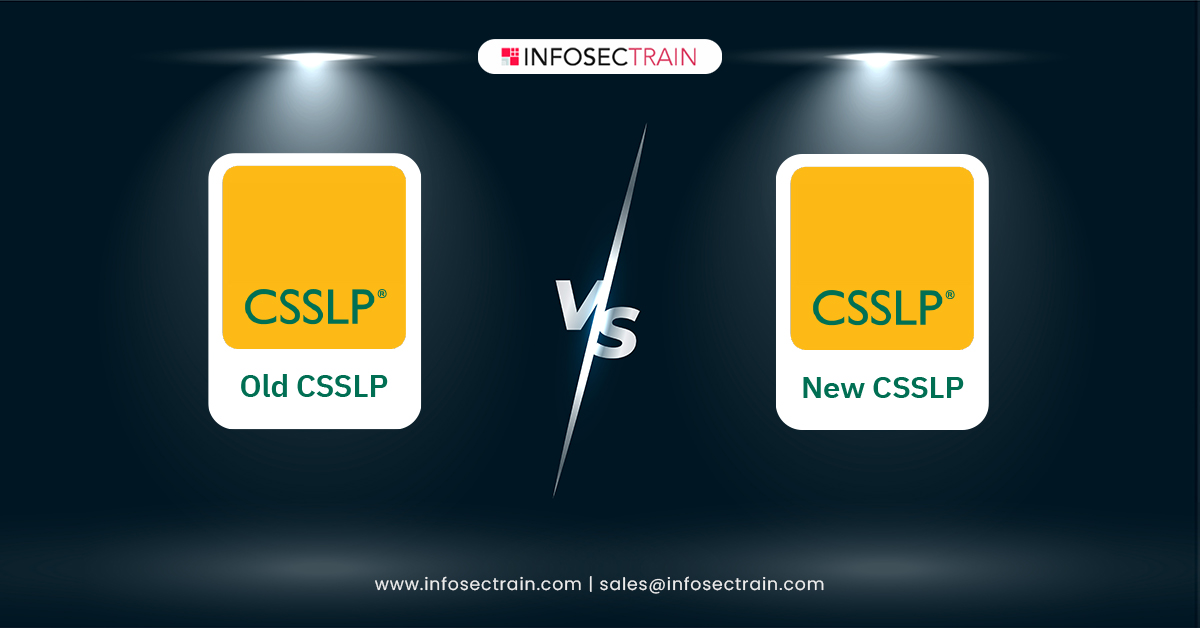Old CSSLP vs New CSSLP Certification
With breaches, hacks and other security incidents occurring all around the world across every sphere of our digital life, it is imperative to stitch security into every phase of the software life cycle and prevent these incidents. This is exactly what the CSSLP certification from (ISC) 2 does.
The ‘Certified Secure Software Lifecycle Professional’ (CSSLP) from (ISC)2 is ideal for software professionals and security professionals to apply security practices to each phase of the ‘Software Development Life cycle’.

In order to stay relevant with the rapid changes in technology and software, (ISC) 2 follows a rigorous and methodical approach to update its credential exams such as CSSLP. Here are the changes that were proposed and which went into effect September 15, 2020.
Exam information:
| Old CSSLP | New CSSLP | |
| Exam Duration | 4 hours | 3 hours |
| Exam items | 175 | 125 |
| Passing score | 700 out of 1000 | 700 out of1000 |
| Experience requirements | Candidates were expected to have a minimum of four years cumulative work experience in one or more of the eight domains of the CSSLP CBK. | Candidates should have a minimum of four years cumulative work experience in one or more of the eight domains of the CSSLP CBK. |
These are the domain name changes that went into effect September 15, 2020(changes are marked in red)
| Old CSSLP | New CSSLP |
| Domain 1: Secure Software Concepts | Domain 1: Secure Software Concepts |
| Domain 2: Secure Software Requirements | Domain 2: Secure Software Requirements |
| Domain 3: Secure Software Design | Domain 3: Secure Software Architecture and Design (NAME CHANGE) |
| Domain 4: Secure Software Implementation / Programming | Domain 4: Secure Software Implementation (NAME CHANGE) |
| Domain 5: Secure Software Testing | Domain 5: Secure Software Testing |
| Domain 6: Secure Lifecycle Management | Domain 6: Secure Software Lifecycle Management (NAME CHANGE) |
| Domain 7: Software Deployment, Operations and Maintenance | Domain 7: Secure Software Deployment, Operations, Maintenance (NAME CHANGE) |
| Domain 8: Supply Chain and Software Acquisition | Domain 8: Secure Software Supply Chain (NAME CHANGE) |
The weightage of the domains have changed as well and they are reflected below: (decrease in weightage are marked in red and increase in weightage are marked in green)
Exam information:
| Old CSSLP | New CSSLP | |
| Domain 1: Secure Software Concepts | 13% | 10% |
| Domain 2: Secure Software Requirements | 14% | 14% |
| Domain 3: Secure Software Architecture and Design | 16% | 14% |
| Domain 4: Secure Software Implementation | 16% | 14% |
| Domain 5: Secure Software Testing | 14% | 14% |
| Domain 6: Secure Software Lifecycle Management | 10% | 11% |
| Domain 7: Secure Software Deployment, Operations, Maintenance | 9% | 12% |
| Domain 8: Secure Software Supply Chain | 8% | 11% |
These are the detailed changes for each of the new domains of CSSLP (changes are noted in BOLD)
| Old CSSLP | New CSSLP | |
| Domain 1: |
|
|
| Domain 2: |
|
|
| Domain 3: |
|
|
| Domain 4: |
|
|
| Domain 5: |
|
|
| Domain 6: |
|
|
| Domain 7: |
|
|
| Domain 8: |
|
|
These are the detailed changes between the old CSSLP and the New CSSLP certification exam that came into effect, September 15, 2020. We hope that this document helps you to prepare for the new CSSLP exam and crack it right away!
For more of InfoSec Train’s courses and webinars, do visit us at InfosecTrain.







 1800-843-7890 (India)
1800-843-7890 (India)